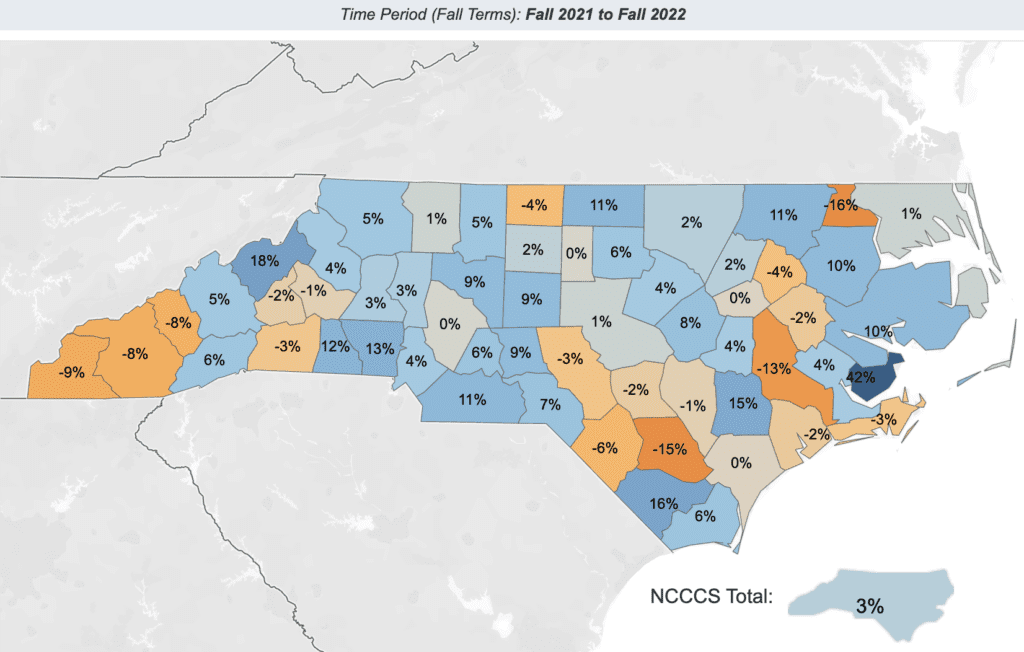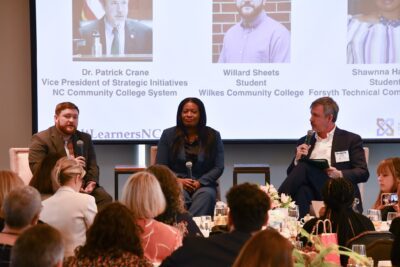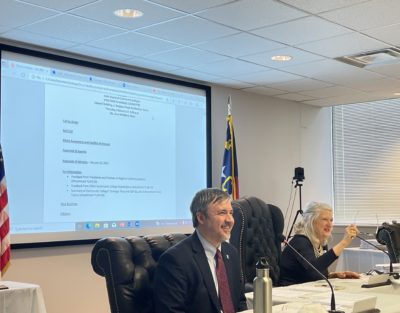

|
|
Enrollment trends for community colleges in North Carolina and nationally are headed in the right direction, but in most cases colleges have not caught up to pre-pandemic levels – much less pre-Great Recession numbers.
State funding is largely tied to enrollment, so it is a trend colleges can’t afford not to watch.
The budget full-time equivalent (FTE) – how the NCCCS is funded for enrollment – is up 1.7% this year, but also down from pre-pandemic levels. The number of students served across the N.C. Community College System (NCCCS), known as headcount, increased 3% this fall, but is down 10% from fall 2019. Both trends impact students and colleges alike.
“Increasing enrollment is probably one of the top two issues that we’re hearing about from community college presidents, trustees, and administrators,” Patrick Crane, vice president of strategic initiatives at the system office, told EdNC last spring. “…We know that there are already significant attainment gaps, educational attainment gaps, by race, ethnicity, and by county across the state. And so not addressing this just continues to widen those gaps as well.”
Many variables impact enrollment, including shifting labor trends, weather-related and population shifts, barriers to retaining students, and more. NCCCS leaders say solutions require being intentional, serving historically underserved populations, and thinking beyond a one-size-fits-all approach.
“Reversing the decade-long decline in community college enrollment is the highest priority for our system,” Burr Sullivan, chair of the State Board of Community Colleges, said last year.
This article takes a look at enrollments trends, the ways FTE is counted and why that matters, along with headcount data and why we need to be thinking more about the total number of students served – and how that relates to investment in community colleges.
History of enrollment trends
While the pandemic exacerbated enrollment declines, it did not create them. Enrollment has been trending down since it peaked during the Great Recession in 2010-11.
Many higher education institutions across the country have seen enrollment declines over the last decade, though the pandemic particularly impacted community college enrollment.
Enrollment declines at our community colleges also largely map with population declines, according to Bill Schneider, NCCCS associate vice president of research and performance management.
In December 2021, he told the State Board that 46 of the 58 colleges had FTE shifts that aligned with population shifts.
Counties with declining populations generally experience enrollment and FTE declines, Schneider said, while counties with population growth tend to see enrollment growth.
With this reality in mind, Schneider said it’s likely more rural colleges will continue to see declining enrollments compared to urban colleges – which would, in turn, result in less funding.
At the same time, many rural community colleges serve a critical role as one of the only postsecondary institutions in their communities.
That role includes training the early child care workforce, training first responders, training the health care workforce, creating opportunities for students in high school through early college and Career and College Promise, providing customized training for industry, imagining the future of work, providing local leadership, and more. It is not clear what community colleges should stop doing in the face of enrollment funding declines.
Enrollment determines funding, staffing, and more
Enrollment in community colleges is one of the simplest ways the system and the state can assess its success in meeting its open-door mission to students across North Carolina.
As EdNC has previously reported:
Declining enrollment at our state’s community colleges is problematic for the state as a whole. Growing economies require an educated population, and a robust community college system expands the number of residents able to get an education.
Understanding this is crucial in the management and evaluation of the community college system. Not only does enrollment signal the demand for education in our state, but it also has significant ramifications for how community colleges are funded, staffed, and measured for success.
Enrollment at community college is broken into three main categories: curriculum, continuing education, and basic skills courses.
Students do not take a uniform number of classes, and classes can be worth a variety of credits. So universities have developed a unit of measure called full-time equivalent, or FTE, that uses a set number of credits to define a full-time student rather than rely on a traditional headcount. This allows colleges to look at their student body in the aggregate for budget and planning purposes. In plain terms, it allows the college to count multiple part-time students as one full-time student based on the number of credits taken. The state then bases funding on the number of full-time equivalents.
Currently, one FTE is equivalent to 512 hours of instruction.
Many feel that funding based on FTEs, not actual students, misses many of the costs associated with part-time students, such as career counseling, tutoring, mental health, and other wrap around services.
Colleges must provide the same support for students, whether they are taking one course or they are full-time students.
What is happening nationally?
Nationally, community college enrollment is starting to grow this spring (+2.1%), according to February 2023 data from the National Student Clearinghouse Research Center.
That growth is largely fueled by increased enrollment among dual enrollees (age 17 and under) and freshmen, the report says. The growth is taking place at community colleges in cities, suburbs, and rural regions, unlike trends across four-year institutions reflecting rural declines.
This research is based on unweighted enrollment counts to emphasize year-over-year changes in enrollment patterns, rather than estimating total enrollment numbers.
Trends in FTE in North Carolina
It is important to note the difference between actual FTE, budget FTE, and instructional FTE.
Actual FTE reflects instruction shared between colleges and also adjusts for errors in previous term reporting. To see actual FTE data, start here. Once actual is clicked at the bottom of that page, you can then click on the tabs throughout the dashboard to see the data.
Budget FTE reflects the number of FTE for which colleges are funded through state funding formulas. To see budget FTE data, start here. Once budget is clicked at the bottom of that page, you can then click on the tabs throughout the dashboard to see the data.
This year, the NCCCS estimated an overall 1.7% increase for fall 2023 in budget full-time equivalent (FTE) – also included in Gov. Roy Cooper’s recommended budget and the proposed Republican House budget.
That 1.7% increase represents an additional 3,800 FTE, NCCCS Vice President and Chief Financial Officer Brandy Andrews told lawmakers last month.
“While the basic skills instruction shows the highest percent increase, I would like to call your attention to the workforce continuing education increase of almost 1,600 FTE,” Andrews said. “This shows our colleges are working hard delivering programs for students to meet workforce needs.”
Here is the dashboard for instructional FTE data. You can select to see system or college data, the reporting time frame (terms or years), and more.
Thirty-eight N.C. community colleges saw growth in their instructional FTE from fall 2021 to fall 2022.


In comparison, only 11 colleges have seen increases in instructional FTE since before the pandemic in fall 2019. NCCCS instructional FTE is down 7% overall since then.
One of those schools – James Sprunt Community College – is a sizable outlier, with a 44% increase in FTE since fall 2019. President Jay Carraway said he believes one reason for the continued growth is how intentional the college has been about recruiting and marketing.
“There’s a lot that goes into recruiting and retaining students… We are very intentional about what we do and how we do it,” Carraway told EdNC. “From the time you drive off the state road, and you come onto our campus, you begin to see that we pay attention to detail.”
At South Piedmont Community College, President Maria Pharr credits the school’s success in enrolling more students to “a new approach to education” – Learning Reimagined. The Learning Reimagined program aims to increase access, remove barriers, and provide flexibility to meet diverse student needs by expanding learning options like HyFlex, adopting an online textbook model, and creating several short-term credentials, among other things.
“After the pandemic and recent economic challenges, many people have been re-prioritizing their careers and goals, and many turned to higher education to make their new goals a reality,” Pharr told EdNC. “At South Piedmont Community College, we’ve been able to meet that changing demand through investments in technologies and the willingness to meet the contemporary needs of our students.”
A look at headcount data
Headcount data is unduplicated within the time period, within individual colleges, and within the system. Here is the dashboard.
Approximately 574,378 students were enrolled in the system over 2021-22, which you can find by selecting the “2021-22 reporting year” option on the dashboard.
To get more recent data, you need to compare enrollment year-over-year by term. Data from groups like the National Student Clearinghouse Research Center typically report on enrollment trends using headcount data.
The number of students served across the NCCCS increased 3% from fall 2021 to fall 2022, according to NCCCS headcount data, with 377,462 students enrolled in at least one class last semester. That’s a 10% decrease from before the pandemic, in fall 2019, or 44,000 fewer students.
Across the system, only five colleges have seen increases in headcount from fall 2019, pre-pandemic enrollment: Davidson-Davie (5%), South Piedmont (5%), Brunswick (4%), Montgomery (2%), Beaufort (0% but 19 students).
Each of the other 53 community colleges have seen decreases in headcount since fall 2019, ranging from 1% all the way to 34%.
Enrollment of adult learners on the rise
The investments being made in adult learners help us see why headcount matters.
The number of adult learners enrolled in N.C. community colleges increased by 10% since the system launched its two adult learner pilot programs, according to a press release. The enrollment of adult learners saw particularly strong growth in short-term workforce and continuing education courses, the release said.
North Carolina has two adult learner pilot programs, N.C. Reconnect and REACH, to reach students 25 and older at 29 participating colleges. The initiatives focus particularly on older students who have received some college credits previously, but have not graduated.
From 2020-2022, adult learner enrollment increased from 171,759 to 189,004.
The largest enrollment growth took place in workforce and continuing education courses, increasing 19% in the same time period. Those short-term courses are designed to provide individuals the skills and credentials needed to gain fast employment in high-demand industries. Additionally, adult basic skills increased by 37%.
Roughly half of North Carolina community college students are adult learners, and 58% were employed full time while taking college courses in fall 2022, the release said.
However you count it, who is not enrolled?
Nationwide, 400,000 fewer men attended college in spring 2021 than in spring 2020, an enrollment decline nearly double that of female students.
At N.C. community colleges, Black men suffered the largest enrollment decline, with enrollment declining 21% from fall 2019 to fall 2020 for this group. There were still about 10,000 fewer Black men enrolled across the NCCCS last fall from before the pandemic.
Community colleges enroll some of the most diverse student populations, including in North Carolina. That means at least part of the solution to enrollment declines must include colleges meeting diverse student needs.
“They are 16 years old and they’re 73 years old and they’re everything in between,” Janet Spriggs, president of Forsyth Technical Community College, told EdNC last August regarding community college students. “They are working parents, single mothers, and they’re facing all kinds of life circumstances that most people don’t recognize.”
Many NCCCS leaders say their colleges are enrolling more part-time students, and that it often takes more resources to support part-time students. At the same time, colleges must enroll more part-time students to receive the same budgeted FTE as for full-time students.
In recent years, North Carolina community colleges have increasingly added support to help all their students stay in college – part- and full-time alike.
Over 40% of fall 2020 community college first-year students did not return to college their second year, according to data from the National Student Clearinghouse Research Center (NSCRC).
Retention and enrollment must go hand in hand, according to Wake Technical Community College President Scott Ralls. Wake Tech – the system’s largest campus – has seen a 10% decrease in the number of students enrolled as of fall 2022 compared to before the pandemic.
“If you’re interested, as we have been in the community colleges for years, in student success, student success comes through completion. And retention is about completion,” Ralls previously told EdNC. “So the enrollment battle — much more of it is about how you retain students than it is about just recruiting new students. You can’t get to your completion goals without retention, and you can’t get to your enrollment goals without retention either.”










